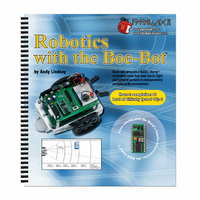28125 Parallax Inc, 28125 Datasheet - Page 337

28125
Manufacturer Part Number
28125
Description
TEXT ROBOTICS
Manufacturer
Parallax Inc
Datasheet
1.28125.pdf
(360 pages)
Specifications of 28125
Title
Robotics with the Boe-Bot
Product
Microcontroller Accessories
Lead Free Status / RoHS Status
Not applicable / Not applicable
- Current page: 337 of 360
- Download datasheet (5Mb)
Calibrating Using a Linear Approximation
The photoresistor is often referred to as a non-linear device. In other words, if it returns
one measurement at one brightness, that doesn’t mean that the measurement will be five
times as large when the light is five times as bright. The math is more complicated and
involves logarithms. However, in cases where the measurements are confined over a
narrow range of the sensors overall detection abilities, the sensor can be treated like it’s a
linear device. You can take a couple of measurements, and then figure out how the
device will react if other measurements in its range could be plotted in a straight line.
The technique is called linear approximation.
Another thing you can do with linear devices is assume the difference between the two
lines can also be plotted as a line. In fact, if you have one linear device that has larger
measurements than the other for ambient and low light, you can use a linear
approximation for making the sensors return approximately the same values for the same
light levels. For every reading from one sensor, (we’ll call that one x), you can multiply
it by a scale factor (m), and add it to a constant (b) to get a value in the same range the
other sensor would report (y).
Here is an example of how to get the values of m and b to match the left photoresistor
circuit to the right. First, assign X
to the right photoresistor values.
mismatched photoresistors. Your values will be different.
Now, solve for m and b using two equations in two unknowns. One of the simpler
approaches is to write two y = mx + b equations, one in terms of X
in terms of X
m.
y
Duration Values
timeLeft
X
X
=
1
2
mx
= 36
= 152
2
and Y
+
b
2
Table F-2:
. Then, subtract one from the other to eliminate b. Then, solve for
timeRight
Y
Y
1
2
= 56
= 215
RC-Time Measurements in Ambient and Low Light
1
Description
Photoresistors in uniform ambient light
Photoresistors in uniform low light
and X
(Table F-2) shows some example values for
2
to the left photoresistor values and Y
1
and Y
1
and the other
1
and Y
2
Related parts for 28125
Image
Part Number
Description
Manufacturer
Datasheet
Request
R

Part Number:
Description:
Microcontroller Modules & Accessories DISCONTINUED BY PARALLAX
Manufacturer:
Parallax Inc

Part Number:
Description:
BOOK UNDERSTANDING SIGNALS
Manufacturer:
Parallax Inc
Datasheet:

Part Number:
Description:
COMPETITION RING FOR SUMOBOT
Manufacturer:
Parallax Inc
Datasheet:

Part Number:
Description:
TEXT INFRARED REMOTE FOR BOE-BOT
Manufacturer:
Parallax Inc
Datasheet:

Part Number:
Description:
BOARD EXPERIMENT+LCD NX-1000
Manufacturer:
Parallax Inc
Datasheet:

Part Number:
Description:
CONTROLLER 16SERVO MOTOR CONTROL
Manufacturer:
Parallax Inc
Datasheet:

Part Number:
Description:
BASIC STAMP LOGIC ANALYZER
Manufacturer:
Parallax Inc
Datasheet:

Part Number:
Description:
IC MCU 2K FLASH 50MHZ SO-18
Manufacturer:
Parallax Inc
Datasheet:














